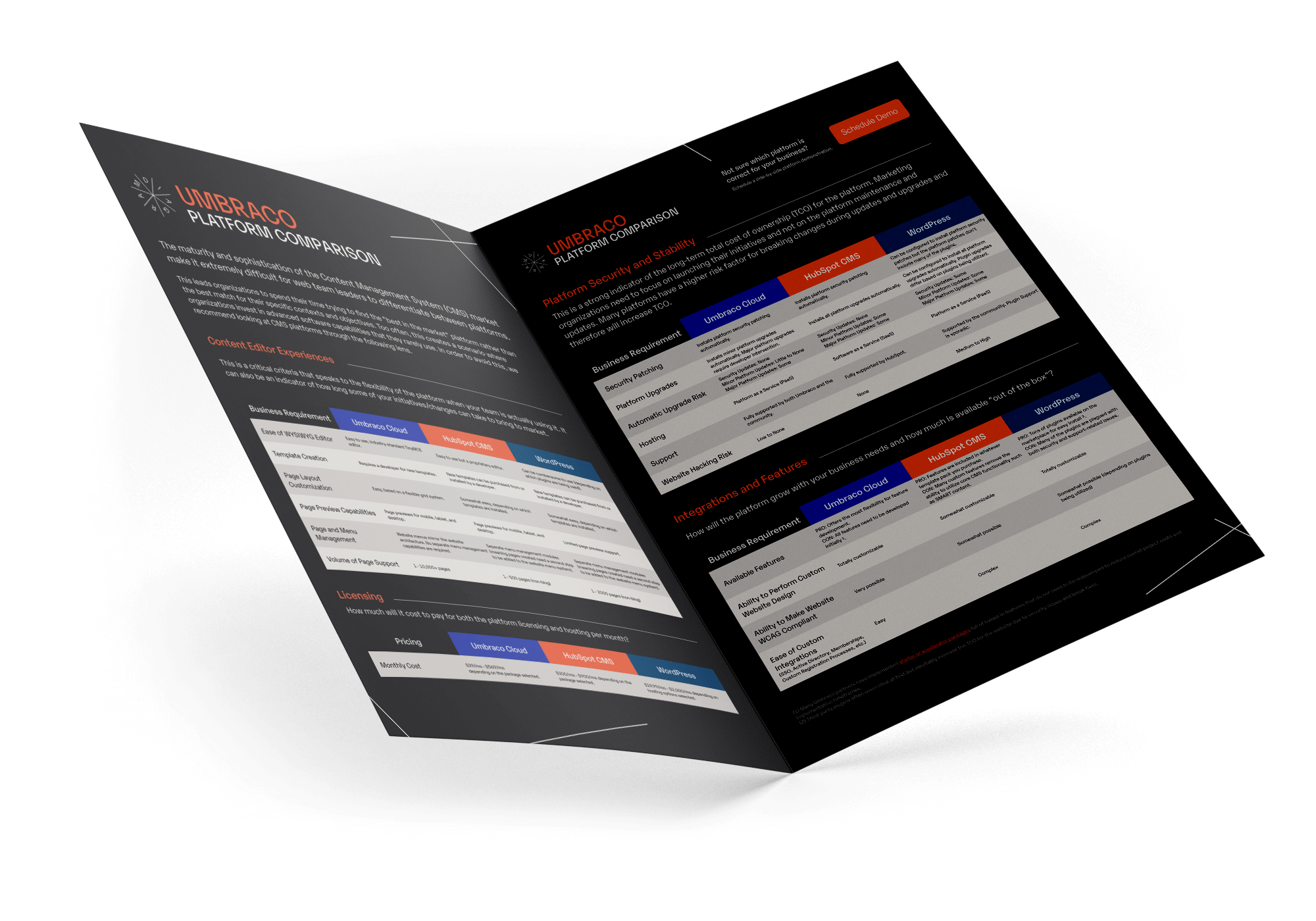Budgeting for a Platform Migration During a Pandemic
Chris Osterhout SVP of Strategy#Digital Strategy

Diagram's Chris Osterhout answers common questions to help secure budget for a CMS migration during the global pandemic.
The following is a transcription of the above presentation:
Speaker: Welcome to Diagram Views Unfiltered, mini episodes where we answer your questions to make you digital heroes at your organization.
Chris Osterhout: My name is Chris Osterhout and today, we'll be discussing how to budget for a platform migration during a pandemic. Whether you're an eCommerce organization looking to migrate to a more sophisticated eCommerce platform, or whether your website serves a more traditional sales and marketing role of lead generation, or increasing brand awareness, requesting the budget to migrate to a new platform has always been an uphill battle, regardless of the state of the economy. Factor in that we're in the middle of a global pandemic and that makes everything that much more complicated.
Today we're going to talk about five tactics that you can use within your organization to not only seek, but also receive the budget approval to migrate to a new platform within your next fiscal year.
Tactic number one, splitting the budget. Now splitting the budget is not the same as spreading the budget and let me explain. Spreading the budget is a tactic that is used in many organizations, where you budget for half a project in one fiscal year and reserve the latter half of the budget for a second fiscal year. This, in itself, carries a fair amount of risk. If you don't get the budget approval in the second year, then the project's only half done, and you don't have the budget to complete it. When I talk about splitting the budget, I'm really talking about an educational process where you educate the different departments in your organization in order for them to contribute to the overall migration budget so that each department is asking for a little bit of money rather than one department asking for a lot of money.
Let me explain. So, let's assume, for the sake of this discussion, that a platform migration will cost $100,000. In fairness, that's probably a low, depending on the type of platform that you're moving to, and hosting fees, and so on, and so forth. However, for the sake of this discussion, let's use the round number of $100,000. If, for example, you can talk to the IT department and help them realize the cost savings from an IT perspective on licensing, let's say, they might be willing to make an investment for the migration in order to achieve the long-term cost savings of reduced licensing costs. Whereas, let's say if you work at a higher education organization, the website is the university's face. It might be worth a discussion with the admissions department and explain how elevating the interfaces for the website and introducing new features available in a digital experience platform, may very well result in additional student applications for the university. So, if you could take that budget and spread it across multiple departments, then each department may be only asking for $25,000. Rather than, say, the marketing department, asking for $100,000. This tactic often results in no net new asks above the normal fiscal budgets, but spreads the budget across multiple departments.
Tactic number two, reallocating the budget. This is probably one of the best and most critical items to take a look at, especially with the pandemic going on. If you're one of those types of organizations that have multiple types of media investments, or traditional marketing investments, such as billboards, or radio spots, thinking about what's happening with the pandemic, with less and less people commuting, possibly not being stuck on the interstate listening to your radio spots, or seeing your billboards on the interstate, it might be one of those scenarios where you think these investments may not be as effective as they were previous years. And what should we do with these funds? It might make sense, say, if you're an organization that spends $1 million annually on these traditional marketing efforts, to say, "Let's carve out $200,000 from this traditional marketing investment and move it to a digital marketing investment." So, you could take $100,000 from that digital marketing investment and apply it towards the platform migration. Then you could take another $100,000 and apply it towards digital marketing, PPC, SEM, marketing automation, that kind of stuff, and the reason that's very exciting is that traditional marketing is hard to measure, not that it can't be measured. It is very difficult to connect the dots between billboards and radio spots, to actual, either sales or leads, because, unless someone tells you that they saw you on a billboard or that they heard a radio spot, sometimes you don't get a closed-loop reporting on that. Whereas, in digital marketing, you can track website sales, website leads, etc., to the different digital marketing campaigns that you're running, and really see the ROI from that. So, reallocating the budget from one section of your marketing to another often will yield a huge return, but also will not increase the overall investment, year over year.
Tactic number three, depreciating the asset. This is probably one of the more complicated tactics that we'll talk about today. But I think it's one of the most effective, specifically if you have a large-scale project. So many organizations, like yours, have the opportunity to depreciate assets that they might have on their books, like vehicles, or buildings, etc. When they do that, it's really about the books spreading the costs of that asset over the course of many years. So, what happens is, and I found this out through many discussions with our CFO of our company and CFO's of other companies, is that website projects, as long as you have the right terms in your contractual agreements with the agency you're building it with, can be depreciated, just like any other asset. You can treat a website like an asset. And so, when I found this out, and I started talking to CFO's about it, they got really excited. So, let me give you an example. If, for example, your website project was $100,000 and everything else I've talked about is true, then, when you go to ask your CFO for that $100,000 capital expenditure, your CFO's probably seeing it as really a $10,000 ask because he's probably going to depreciate that asset over ten years, or five years, or eight years, but basically, in the eyes of the CFO, you're asking for substantially less money because even though they're going to pay out the money in capital investment, that can be depreciated on the books over many years. And so, I can give you a few examples of this.
So, a couple of years ago, I had a $1 million project with an organization. And I talked to their CFO about it and talked about the depreciating the asset. And he did some due diligence and made sure that we had the paperwork, in order that we'd be required to do that. And confirm that they were, indeed, allowed to do that because it is a kind of foreign concept to a lot of CFO's, who aren't used to web projects, more used to normal assets. And he came back to me and said, "Hey, Chris. What's the possibility of making this project bigger? What else can we do to move our company forward, as part of this bigger initiative, so that we can depreciate more money over a ten-year run?" And so, all I can say is that this is a tactic that works very well if you have the right conversations with the right people in your organization and that your organization is receptive to looking into this and making sure that it is the right fit for the type of need that you're looking for.
Tactic number four, understanding the total cost of ownership. So, I think this is really important when you're looking at a platform migration to understand and really understand how much your current website actually costs to run. And what I mean by that is most organizations, shield say the marketing department, from the underlying costs of the licensing, the hosting, and all of that kind of stuff. But the reality is, that is really important information when you're looking at budgeting for a platform migration to understand how much that really costs the organization to run. So, for example. We had a client that hosted at Rackspace a couple of years ago and there's nothing wrong with Rackspace. Love that organization and it’s a great hosting company. We have a lot of clients that host there. But basically, they had nine servers, a bunch of security equipment, and switches and firewalls, and so on, and so forth. And their annual investment at Rackspace was close to $250,000 a year, which, you know, when we took a look at migrating them to a new digital experience platform, we basically were able to move that $250,000-year investment down to $100,000 a year, on the new Digital Experience Platform. And so, we already realized, right there, a $150,000 in savings. And so, taking that example that we had earlier, about a $100,000 migration cost for a website, you could take $100,000 from that $150,000 savings, apply it to the platform migration, and essentially, still net $50,000 in savings. So, really understanding all the nuances of what it costs to run a website and what your total cost of ownership for your web property is, is super beneficial and helpful when you're looking at justifying the investment to move to a new platform.
Tactic number five, helping the website pay for itself. So, this primarily relates to eCommerce customers. So, let's use that, as an example, for this particular tactic. Let's just say that your existing eCommerce platform does not have an abandoned cart recovery process. So, when you're thinking about migrating the platform, you're looking at these features like abandoned cart recovery, cross-sell, upsell, that kind of stuff all these opportunities to make more revenue for your organization. But the question remains, how much revenue can you make? And so, what I want to do is give you an example today and then, help you figure out how much this translates to for your organization. We have some customers that we've migrated from one eCommerce platform to another and the previous eCommerce platforms did not have any of those features, like abandoned shopping cart recovery. After we migrated them to their new platform, they were able to realize a 150% return on investment of their entire platform migration cost in one month.
So, what I mean by that is they were able to recoup the entire cost of their migration and then some, within one month of launching on the new site. So, how did they do this? They did it because they were able to recover all the money, they were leaving on the table by not trying to recover these abandon carts that were happening on their website. How would you figure this out for yourself because it makes a very compelling discussion for your leadership when you say, "Hey. We can pay for ourself, in a certain amount of months, if we migrate now." Depending on the eCommerce platform that you're on, you can either do a database query or you can look in an administration console, but what you're looking for is the total sum of the baskets that were created within the bounds of one month, but not completed. Meaning they started the checkout process but never completed it and don't be surprised if you see pretty large numbers. I wouldn't be surprised to see things in the hundreds of thousands, if not millions, of dollars that are left on the table every month. It is very common. So, don't be surprised.
So, what you do is, the average shopping cart recovery rate is around 3%, on average. What you can do is take that total number of your shopping carts per month, the total value of the items in the cart, and multiply that by 3%. So, let's use some simple math here. So, let's pretend that you have $2 million a month in abandoned shopping carts. If the average recovery rate is 3%, then you'd be looking at recovering upwards of $60,000 a month in abandoned cart revenues—some money you would not have had otherwise. So, that makes a pretty easy sale for you with your leadership team, saying, "Hey. We can pay for the website migration costs in two months of go-live. Here's how I know that --" and you lay that out for them. So, really understanding your metrics, specifically if you're in eCommerce, and how the new platforms will help you generate money quicker and bring more value to your organization, is a great way to seek and receive budget approval for a migration.
Now, if there's one thing I want you to remember, or get out of this entire discussion today, is that regardless of all the tactics we discussed previously, the cost of doing nothing your next fiscal year is not zero dollars. Let me explain that to you. So, let's pretend you are an eCommerce website. Let's just use eCommerce as an example because it's the easiest to conceptualize for most organizations and most individuals, but imagine if you do nothing different with your website for another 12 months. Meanwhile, your competitors continually are enhancing the feature set on their website to make it easier for consumers to purchase their products and reorder products, and so on and so forth. And so, what happens is your consumers, your customers, start buying the same products from your competitors because it's easier, and its less friction, as they try to make those orders on that website. So, even though you didn't increase your investment in the website this year, you also had a net loss of customers buying on your website. When I'm saying when the cost of doing nothing is not zero dollars, what I mean is you could actually lose money by not trying to stay ahead of what your customers need and want. Thank you so much for spending the time with me today. I'd love to hear any questions or comments you might have. You can reach out to me directly on our website wearediagram.com and please stay tuned for future Diagram Views Unfiltered.
Related Posts
![3 CMS Platform Migration Considerations [Mini Episode]](https://www.wearediagram.com/hubfs/Diagram-Views-Unfiltered-Transparent-BG-All-Black%20small.png)
3 CMS Platform Migration Considerations [Mini Episode]
Diagram's Chris Osterhout shares three essential tips that your organization should consider when moving to another CMS platform.

Why You Need an SEO Content Audit in your Migration Plan
Diagram's Allison Casey spills all her insider SEO tips on migrating your content the right way.
Results Matter.
We design creative digital solutions that grow your business, strengthen your brand and engage your audience. Our team blends creativity with insights, analytics and technology to deliver beauty, function, accessibility and most of all, ROI. Do you have a project you want to discuss?
Like what you read?
Subscribe to our blog "Diagram Views" for the latest trends in web design, inbound marketing and mobile strategy.


